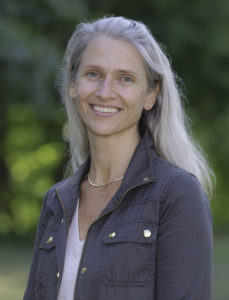Getting Things Right
Message from the headmaster
A couple of months ago, senior Hailey Buick and woodworking teacher Matt Stark asked me to visit the wood shop to see Hailey’s Senior Capstone project, which was to build a rocking chair.
As teacher and student described the unique difficulty of making such a chair, and the talent combined with hours and hours of dedicated work it took to build it, I took a seat and tested it out right there in the shop. A tall ladder-back rocker with a sturdily woven seat, this chair keeps your posture proper and doesn’t just recline; but it also doesn’t fight the sitting back, and carries a first push smoothly into rhythm.
So I was delighted to find this compelling and triumphant chair already on Fuller Hall stage, next to the podium, when we arrived for Monday morning Chapel. Hailey offered to put the chair there in order to inspire other students to think broadly about what they might accomplish while they’re here.
Sharing the stage with this chair, and contemplating its form and function, gave me an opportunity to talk about how complex and precise the forces are that allow us to find comfort and equilibrium in the world. Part of lining things up so they sit the way they should, or move the way they should, is called “justifying”—making right, making just. The root of the verb “to justify” is from the Latin Justus—“right” or “upright”—which is of course also the root of the word “justice.”
It’s helpful to think about justice in terms of straightening things up—of placing things in proper proportion so that they obey laws, so the world can line up along the laws that we have made for living together in peace and harmony. The just elements of the chair contribute to its ability to obey higher laws—laws of nature that allow us to stay balanced physically and not fall. But it doesn’t only obey these laws or recognize them enough to conform—this chair made right actually helps us stay balanced—not only so we can sit right, sit straight, and not fall, but also so that we can enjoy the play and fight of forces that govern our balance. It’s a celebration of our ability to take active pleasure in something working the way it should; something that allows us, if we choose to see it this way, to participate in getting things right, in rightness itself.
There are things happening in the world today that can make it difficult to believe that justice is the natural state of things, or even that it is achievable. The pandemic has upended all of our assumptions about how we can move safely through the world. Violence does the same thing; it is the definition of injustice to violate and destroy those things that have been carefully and meticulously made to stand and sit right. And violence cannot solve injustice or restore the peace of things in balance; only versions of the care, patience, and determination that Hailey summoned to make this chair can do that.
There is fighting in the Middle East that some would say is the response to ongoing injustice there—people may feel differently about what constitutes the right balance of forces that would end that conflict, but I imagine and hope that they agree that balance cannot be found by continuing to fight and kill.
There is ongoing injustice in our own society that gives some the illusion of balance at the expense of others’ oppression—the killing of George Floyd last summer has not been undone by the conviction of the man who murdered him, but that verdict, that saying of truth, is a recognition of what balance looks like, what peace might look like.
It might seem a stretch to take a common thing like a well-made wooden chair and give it so much significance—to make it a sign of peace and justice—but to that, I would say two things. First, poets have already done it (see Pablo Neruda, Ode to the Chair: “War is as vast as the shadowy jungle./A single chair/is/the first sign/of peace”). Second, there is inherent elemental value in turning a natural material to our use and making strong objects that serve us while being beautiful—especially in a culture where we discard things so easily, there is value in durable things.
What prompted Hailey to want to share the beautiful, durable thing she made with the community was the hope that her peers would aspire to create beautiful, just, and enduring things of their own out of their own materials. No doubt that is the right hope for us all.

Dr. Sharon L. Howell
Headmaster

